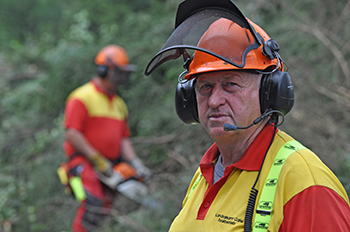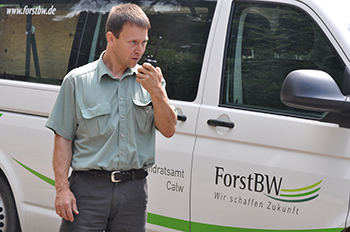 Situated in the state of Baden-Württemberg in south western Germany and bordered by the Rhine valley to the west and south, the Black Forest is a world renowned wooded mountain range covering 11,100 square kilometres.
Situated in the state of Baden-Württemberg in south western Germany and bordered by the Rhine valley to the west and south, the Black Forest is a world renowned wooded mountain range covering 11,100 square kilometres.
It may be best known for its breathtaking scenery, Horst Jankowski’s million selling ‘A walk in the Black Forest’ and Schwarzwälder Kirschtorte (Black Forest Gateau) but today it is a major centre for both tourism and forestry.
The Forestry Commission of Baden Wurttemberg is responsible for the management of the forest and its timber resources.
Employees of the Forestry Commission of Baden Wurttemberg, now work more safely and efficiently thanks to professional radio communications equipment from Kenwood.
The Forestry Commission issued a request for proposals to upgrade their communications system which prompted radio dealers from all over Europe to respond with their solutions and submit tenders. Amongst those was Blickle and Scherer Gmbh and Co. KG based in Karlsruhe, Germany, who have specialised in professional radio communications since 1998.
B & S Project Leader Mr Peter Bahm, carefully studied the brief before submitting a proposal based on a combination of Kenwood TK-2360E analogue hand-portable radios used with a specially adapted Peltor headset. A high capacity battery, nylon case and matching charger completes the
package. Mr Bahn commented: “This package offered the best possible solution to meet the criteria the Forest Commission set out in their tender for a number of reasons.
 First and foremost, having worked with Kenwood equipment in the past we knew they would perform reliably in the harsh operating environment of forestry. Second, the compact dimensions of the Kenwood TK-2360E radio along with its robust construction and heavy-duty, yet lightweight Li-Ion battery KNB-57L delivering 2000mAh made them ideal for the application which requires the radios to be carried by the operator at all times and last, but not least, the price performance equation delivered by the combination offered best value to the customer”.
First and foremost, having worked with Kenwood equipment in the past we knew they would perform reliably in the harsh operating environment of forestry. Second, the compact dimensions of the Kenwood TK-2360E radio along with its robust construction and heavy-duty, yet lightweight Li-Ion battery KNB-57L delivering 2000mAh made them ideal for the application which requires the radios to be carried by the operator at all times and last, but not least, the price performance equation delivered by the combination offered best value to the customer”.
Of course, what looks good on paper can often fail in practice and with a requirement for 1,250 hand portable radios, the Forestry Commission quite rightly requested tests to be conducted to verify the performance of the equipment under live operating conditions.
The positive feedback from the field trials provided by end users confirmed that Mr Bahn had selected the right solution with the low weight, compact size, range and voice quality of the equipment contributing to it being rated as both the most comfortable and reliable solution.
Safety First
Forestry operations can be dangerous and a further key consideration in the final selection of the Kenwood radio system was the advanced safety features it offered such as the man-down function, which can be programmed by the customer to automatically send alert messages to an individual or group in the event of an emergency, for example, should the radio not be kept in an upright position or where it has remained static for a defined period of time.
To gain a better understanding of how the end user would be using the Kenwood equipment in daily operations, we visited the forestry’s harvest and maintenance operation around Bad Liebenzell in the Black Forest.
 Frank Lindenberger, leads a team of 15 men who have been working with the Kenwood radio equipment
Frank Lindenberger, leads a team of 15 men who have been working with the Kenwood radio equipment
Lindenberger comments: “No one can afford to operate without a reliable two-way radio system in forestry especially in emergency situations where safety is paramount. Equally, the efficiency gains in, for example, being able to coordinate heavy lifting equipment or transport so that it is precisely where it’s needed when it’s needed can’t be underestimated when you’re trying to maximise productivity” Lindenberger continued: “Whenever possible, we also ensure that third party contractors working with us are equipped with a radio”.
Forestry Commission foreman Mr Mirco Bijelic confirms the benefits of the Kenwood system, saying: “The noise generated by teams of workers felling trees, even when working only two tree lengths away from each other, makes it impossible to communicate without a radio. In addition to the obvious benefits to safety, coordinating work and planning next tasks with colleagues also becomes much easier”. To prove his point, Mr Bijelic used his radio to invite colleagues working in other parts of the forest to join us for a lunch break.
During the break we were able to get feedback from other users of the radio system. “The Black Forest landscape features a lot of steep slopes and it is a real benefit to be able to communicate with colleagues instantly from where you are working. Previously we had to leave our working area and trek up and down slopes just to talk to a colleague”, explains Mr Roland Dreisigacker, who works in the same team as Mr Micro Bijelic.
During our conversations we cover a range of topics including how comfortable the equipment is when worn all day and its suitability for day-to-day operations. Mr Dreisigacker continues: “Everyone agrees the big advantage of the system is in its low weight. Our tool belt, the chain saw and everything else we have to carry is quite heavy and every gram saved counts. Compared to our old radios, the Kenwood TK-2360E is not just smaller, but also lighter thanks to the Li-Ion battery”.
The consensus from all the other users is that the compact radio in its nylon carry case with belt loop is comfortable to wear and that the cable from the headset to the radio, correctly routed, does not get in the way when working, in addition, the headset and big PTT button can be used safely and easily, even when wearing thick gloves.
Listening to the men, it’s clear that the radios have become a natural addition to their everyday tools and equipment. “This is evident in the way the radios are handled and cared for. Every person has his or her own radio and is responsible for charging the battery at home. There is no central charging station or storage facility for the radios – this method of making the operator responsible for their own equipment is tried and tested” explains Mr Lindenberger.
The habit of charging the battery every night ensures that the radios are always ready for operation. Thanks to Lithium-Ion technology the batteries do not suffer from ‘memory effect’, which degrades the battery capacity over time should a battery be charged, without first being fully discharged.
Mr Dreisigacker confirms that the men take great care of their radios and adds: “To find out for myself how long the battery lasts I didn’t charge mine for two days”, he stressed: “It’s not something I would usually do and we have never experienced a situation where a colleague has arrived at work with an empty battery. Safety is far too important for all of us to leave anything to chance.”
 |
|
 |
|
 |
|
Forest BW
Wonnhaldestraße 4
79100 Freiburg
Deutschland
|
|
Blickle & Scherer Kommunikationstechnik GmbH & Co. KG
Konrad-Adenauer-Allee 1-11
Gewerbering 4-6
Deutschland
|
|
Kenwood Electronics Deutschland GmbH
Konrad-Adenauer-Allee 1-11
D-61118 Bad Vilbel
Deutschland
|
|
T: +49 (0)761 / 4018 – 0
F: +49 (0)761 / 4018 – 333
W: www.fva-bw.de
|
|
T: +49 (0)721 / 97 36-400
E: info@bsk-world.de
W: bsk-world.de
|
|
T: + 49 (0) 6101 – 4988 – 500
F: +49 (0) 6101 – 4988 – 509
W: www.kenwood.de
|